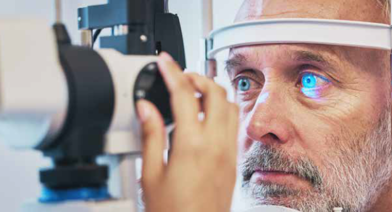Glaucoma
Turning Point for Glaucoma
Is glaucoma ready for an interventional treatment approach?

Howard Larkin
Published: Monday, July 3, 2023
 Current glaucoma treatment models rely heavily on topical medications, generally watching and waiting for progression before interventions such as selective laser trabeculoplasty (SLT) or minimally invasive glaucoma surgery (MIGS). But effective as topical medications can be, they present significant challenges, according to Dr Iqbal “Ike” Ahmed.
Current glaucoma treatment models rely heavily on topical medications, generally watching and waiting for progression before interventions such as selective laser trabeculoplasty (SLT) or minimally invasive glaucoma surgery (MIGS). But effective as topical medications can be, they present significant challenges, according to Dr Iqbal “Ike” Ahmed.
Topical medications’ efficacy depends on patient adherence, which is notoriously poor, and they deliver suboptimal 24-hour intraocular pressure (IOP) control. Eye drops may even be linked to histological changes that could irreversibly damage the conjunctiva, Tenon’s capsule, and, possibly, the trabecular meshwork—potentially limiting future treatment options and promoting glaucoma progression, he noted.
Moreover, adding medications typically results in decreasing returns on IOP lowering in exchange for greater adverse effects and further reduced patient quality of life. Given these drawbacks, “it’s time we redefined what [maximum tolerated medical therapy] really means,” Dr Ahmed said.
New and emerging interventional technologies make it increasingly possible to take glaucoma treatment out of patients’ hands, leading to better 24/7 IOP control and improved quality of life for patients with mild to moderate disease. Better use could be made of these technologies by adopting an interventional approach to glaucoma therapy for first-line and stepwise treatment, Dr Ahmed argued.
The interventional option
“Glaucoma therapy is really changing and evolving,” he said.
While devices currently account for only about 3% of the global glaucoma treatment market, evidence is building for SLT as first-line therapy, and earlier use of standalone MIGS. Combination phacoemulsification and MIGS is fairly well established, and microinvasive bleb surgery is gaining ground. On the near horizon are extended-release drug delivery technologies and non-incisional MIGS.
Generally, early intervention is better, as it delays progression and the need for later interventions after damage is done.
However, Dr Ahmed emphasised choosing the right patient for the right procedure at the right time is critical.
“For me, interventional glaucoma very often addresses that earlier patient who doesn’t need to have aggressive surgery but isn’t best served by medical therapy,” he said. “Glaucoma is only young once. Eventually, glaucoma gets old, and it gets harder to treat.”
What it means
Dr Ahmed described interventional glaucoma as a proactive approach, advising practitioners to consider interventions before disease progression and avoid stacking medications.
Early, predictive diagnostics may help identify when and how to best intervene. Risk factor analysis, ocular biomechanics, genetic testing, digital health records, and artificial intelligence may all support decision-making.
Active, advanced monitoring will help better monitor patients, Dr Ahmed said. Technologies include robust structure and function progression analytics, home monitoring, IOP sensors, and detecting apoptosing retinal cells.
Already, he sees progress towards interventional glaucoma.
“The waiting and watching approach is—I think, I hope—changing, evolving into a more interventional approach,” avoiding a more reactive approach and the progression it may allow, Dr Ahmed said. “We are lucky to have technologies here and coming that allow us to use intervention.”
Dr Ahmed delivered his remarks during the Stephen A Obstbaum MD Honoured Lecture during Glaucoma Day at ASCRS 2023.
Iqbal K “Ike” Ahmed MD is professor at the John A Moran Eye Center of the University of Utah, US. He is also an assistant professor at the University of Toronto, Canada, division head of ophthalmology at Trillium Health Partners, Toronto, Canada, and chief innovation officer at Prism Eye Institute, Toronto, Canada. ike.ahmed@utoronto.ca; ikeahmed@mac.com